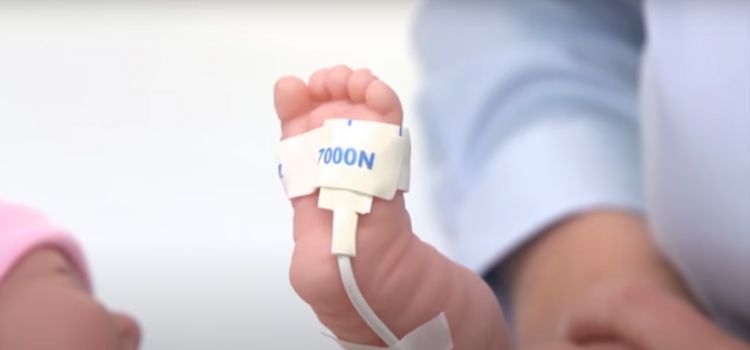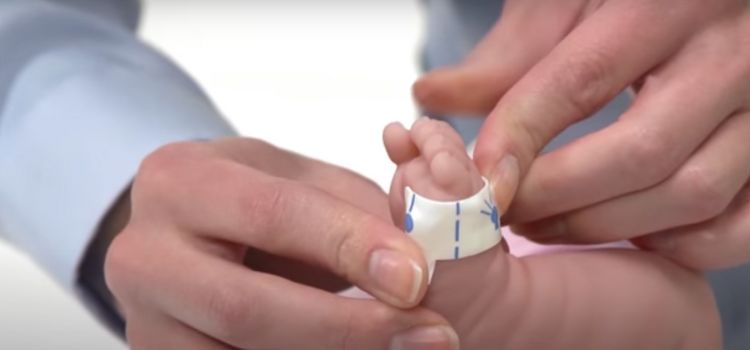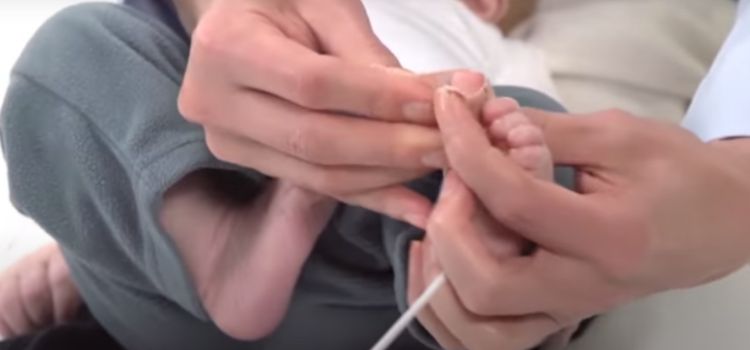As an Amazon Associate I earn from qualifying purchases.
The pulse oximeter is a vital tool for monitoring the health of your child. This device’s ability to measure oxygen levels and pulse rate has made it an indispensable addition to every parent’s medical kit. But how to put pulse oximeter on baby foot? In this blog post, we will investigate the step-by-step process, ensuring that you are endowed with the knowledge and confidence to use a pulse oximeter effectively. So, let’s dive in and learn how to ensure accurate readings while keeping your baby safe and comfortable.

Importance of monitoring a baby’s oxygen levels
The monitoring of a baby’s oxygen levels is crucial for their health and well-being. Parents must be vigilant to ensure that their children receive sufficient oxygen. Using a pulse oximeter to monitor a baby’s oxygen levels is an effective method. This device measures the oxygen saturation in a baby’s blood and provides immediate feedback when placed on their foot. Understanding how to properly place a pulse oximeter on a baby’s foot is essential for accurate readings and early detection of oxygen-related issues. By routinely monitoring a baby’s oxygen levels, parents can safeguard their child’s health and, if necessary, seek medical attention.
Explanation of what a pulse oximeter is and how it works
A pulse oximeter is a medical device used to measure the blood’s oxygen saturation levels. It is a non-invasive device used frequently in hospitals, clinics, and even at home. A sensor is inserted on a person’s finger, toe, or baby’s foot in order for the device to function. The sensor emanates light that is able to penetrate the epidermis and blood vessels. The pulse oximeter can determine the quantity of oxygen in the blood by analyzing the light that is absorbed and reflected back. This information is essential for determining the overall health and oxygenation status of an individual, including infants. To obtain accurate readings when using a pulse oximeter on a baby’s foot, it is essential to position the device securely but delicately.
Preparing for the Procedure:
Gather the necessary equipment
To correctly place a pulse oximeter on a baby’s foot, it is essential to collect the necessary supplies. Having all the necessary instruments on hand will make the process much simpler and more effective. This includes a baby-specific pulse oximeter device, a soft and pleasant wrap or bandage, and a clean and sterilized cotton pad. With these items in hand, you can confidently place the pulse oximeter on your baby’s foot, ensuring accurate readings and the highest level of comfort for your child.
Ensure a quiet and comfortable environment
Putting a pulse oximeter on a baby’s foot requires a few essential measures to ensure a silent and comfortable environment. Find a quiet, noise-free environment in which the baby can unwind. Dimming the lights and playing soothing music can also aid in establishing a tranquil environment. Remove the baby’s hosiery with care and cleanse their foot thoroughly. Place the pulse oximeter on the baby’s foot with care, ensuring that it is secure but not too rigid. It is essential to monitor the baby’s comfort throughout the entire procedure, as their well-being is the top priority. By following these steps, placing a pulse oximeter on a baby’s foot will be a seamless and stress-free experience.
Positioning the Baby:
Choose a suitable location for the baby, such as a changing table or bed
When placing a pulse oximeter on a baby’s foot, it is essential to select an appropriate location for the baby. For this purpose, a changing table or a cot can be optimal options. By choosing a stable and comfortable surface, you can position the baby’s foot correctly for accurate readings. Remember that proper placement of the pulse oximeter is essential for effectively monitoring the baby’s oxygen levels. Therefore, be sure to select a location that offers essential support and convenience for both you and your child.
Place a soft surface underneath the baby for added comfort
When placing a pulse oximeter on a baby’s foot, it is essential to position a plush surface underneath the foot for optimal comfort. By doing so, you can create a comfortable and cushioned environment that will help them remain calm and at ease throughout the procedure. This added comfort will not only make it simpler for you to accurately position the pulse oximeter, but it will also contribute to a positive overall experience for you and your baby. Learn how to place a pulse oximeter on a baby’s foot by following these steps.
Ensure the baby’s foot is clean and dry
Follow these measures to ensure that the baby’s foot is spotless and dried before applying a pulse oximeter. Initially, cleanse the baby’s foot with mild detergent and tepid water, removing all grime and perspiration. Using a soft towel, massage the foot dry, making sure to thoroughly dry between the toes. To ensure accurate readings when using a pulse oximeter on a baby, it is essential to keep the foot clean and dry.
Selecting the Right Pulse Oximeter:
Discuss the different types of pulse oximeters available for infants
There are numerous varieties of pulse oximeters for neonates, each of which provides accurate and dependable oxygen saturation readings. When it comes to placing a pulse oximeter on a baby’s foot, it is essential to follow the correct procedure for accurate results. Included in these stages is securing the pulse oximeter to the baby’s foot without creating distress. In addition, it is essential to choose an infant-specific pulse oximeter, as their small feet require a device with the appropriate size and sensitivity. By comprehending the various varieties of pulse oximeters and how to properly place them on a baby’s foot, parents can monitor their infant’s oxygen levels with confidence and simplicity.
Consider the size, accuracy, and ease of use when choosing the device
When selecting a device to place a pulse oximeter on a baby’s foot, it is essential to consider its size, precision, and usability. The device should be sized appropriately for a baby’s foot to ensure a correct fit without causing distress. Accuracy is essential because it determines the dependability of the readings, allowing parents to effectively monitor their baby’s oxygen levels. In addition, usability is crucial for convenience and comfort during the monitoring procedure. Parents can choose a pulse oximeter that is appropriate for their baby’s requirements by taking these factors into consideration.
Placing the Pulse Oximeter:

Identify the correct foot to attach the pulse oximeter
To accurately affix a pulse oximeter to a baby’s foot, the correct foot must be identified. When using a pulse oximeter on a baby, it is generally advised to position the device on the baby’s foot, as this location provides the most accurate readings. To ensure proper placement, situate the sensor of the pulse oximeter on the baby’s foot so that it is secure but not too rigid. This aids in the accurate measurement of oxygen saturation and heart rate. By following these procedures, it is possible to place a pulse oximeter on a baby’s foot in a safe and effective manner.
Gently hold the baby’s foot and locate the appropriate spot for sensor placement
To position a pulse oximeter on a baby’s foot, grasp the baby’s foot gingerly and locate the optimal sensor insertion location. This phase is essential for obtaining accurate readings and maximizing the baby’s comfort. By following these methods on how to place a pulse oximeter on a baby’s foot, you can easily and confidently monitor their oxygen levels.
Securely attach the oximeter to the foot using the provided straps
To securely affix the oximeter to a baby’s foot, follow these uncomplicated steps. Utilize the suspenders included with the oximeter to ensure a secure fit. Place the oximeter on the baby’s foot with care, ensuring that it is accurately positioned. Ensure that the straps are neither too snug nor too loose before securing them around the foot. This phase is essential for obtaining accurate and trustworthy readings from the pulse oximeter. You can confidently place the pulse oximeter on a baby’s foot and monitor their oxygen levels by following these instructions.
Ensuring Proper Fit and Function:
Make sure the pulse oximeter is snug but not too tight on the baby’s foot
It is important to guarantee a secure fit when situating a pulse oximeter on a baby’s foot. By following the proper procedure, it is possible to accurately determine the baby’s oxygen saturation levels. To apply a pulse oximeter to a baby’s foot, gingerly position and secure the device. This step-by-step guide on how to place a pulse oximeter on a baby’s foot will ensure accurate readings and the child’s comfort.
Verify that the sensor is properly aligned with the baby’s blood flow
It is crucial to ensure accurate readings that the sensor of the pulse oximeter is properly aligned with the baby’s blood flow. For accurate measurements of oxygen saturation and heart rate, proper alignment is vital. Follow these steps when using a pulse oximeter on a baby’s foot to ensure proper placement: First, wash the foot gingerly with moderate detergent and tepid water. Then, affix the sensor to the center of the baby’s foot, ensuring that it is secure. Avoid positioning the sensor too rigidly or too loosely, as doing so can compromise the accuracy of the readings. Once the sensor is appropriately aligned, you can monitor your baby’s oxygen levels and pulse rate with confidence. Refer to the pulse oximeter’s user manual for additional instructions if necessary.
Monitoring the Baby’s Oxygen Levels:
Observe the pulse oximeter readings and understand the oxygen saturation levels
For accurate monitoring and evaluation of a baby’s oxygen saturation levels, it is necessary to observe the readings on a pulse oximeter. Understanding how to place a pulse oximeter on a baby foot is essential for obtaining accurate readings. By following a few simple steps, caregivers can ensure that the device is securely affixed to the baby’s foot, allowing for reliable oxygen saturation readings. Monitoring oxygen levels in neonates is essential for their health and well-being, and a pulse oximeter can provide caregivers and medical professionals with valuable information.
Note any signs of discomfort or irregular readings
When placing a pulse oximeter on a baby foot, it is essential to pay attention to any symptoms of distress or irregular readings. The positioning of the instrument correctly ensures accurate and reliable results. Begin by placing the pulse oximeter on the baby’s foot and ensuring that the sensor is affixed securely. Avoid wrapping it too tightly, as this could restrict circulation. Observe the baby attentively for signs of distress, such as fussiness and discoloration. Additionally, keep a watch out for any erratic readings that could indicate a problem with the device or the baby’s oxygen saturation levels.
Consult a healthcare professional if there are concerns or abnormal readings
Consult a healthcare professional if you have any questions or if you observe any unusual readings. This is especially true when monitoring the oxygen levels of a baby. For accurate readings, it is crucial to understand how to use a pulse oximeter on a baby’s foot. If you have any concerns or queries about using a pulse oximeter on a baby’s foot, you should consult a healthcare professional for assistance.
Removing the Pulse Oximeter:
Carefully remove the pulse oximeter from the baby’s foot
To place a pulse oximeter on a baby’s foot, extreme caution is required. Begin by removing the pulse oximeter from the baby’s foot with care. This ensures a safe and delicate extraction without causing the baby any distress. Handle the pulse oximeter with caution to prevent accidental damage. By adhering to these procedures, the placement of a pulse oximeter on a baby’s foot will be seamless and uncomplicated.
Store the pulse oximeter in a safe place for future use
To ensure the longevity and accessibility of your pulse oximeter for future use, it is essential to store it in a secure location. Not only does proper storage safeguard the device from injury, but it also ensures that it is readily accessible when required. Whether you are using a pulse oximeter for your baby or for yourself, it is imperative that you adhere to the recommended storage instructions. By storing your pulse oximeter in a secure location, you can preserve its functionality and be ready to monitor your baby’s oxygen levels whenever necessary.

Conclusion
In conclusion, it is of the utmost significance to routinely monitor a baby’s oxygen levels for their overall health and well-being. By placing a pulse oximeter on a baby’s foot, parents and caregivers can effectively and securely monitor the infant’s oxygen saturation levels. This monitoring instrument provides reassurance and peace of mind, enabling prompt action to be taken in the event of any concerns. Remember that regular surveillance is essential for optimizing the baby’s respiratory health, and a pulse oximeter can be a valuable tool for achieving this objective.
Amazon and the Amazon logo are trademarks of Amazon.com, Inc, or its affiliates.